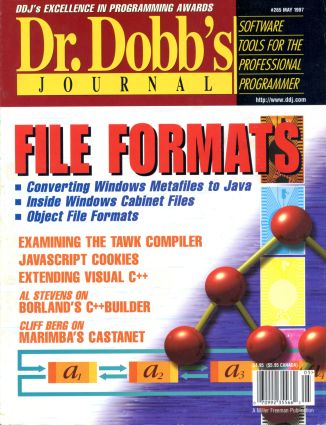
p.6 EDITORIAL
[author : Jonathan Erickson] #Edito
TABLE OF CONTENTS
FEATURES
p.18 DR. DOBB'S JOURNAL EXCELLENCE IN PROGRAMMING AWARDS
[author : Jonathan Erickson]
Cryptographer Ron Rivest and PC pioneer Gary Kildall are this year's recipients of our annual award honoring achievement in the world of software development.
p.20 INSIDE WINDOWS CABINET FILES
[author : Sven B. Schreiber]
The Windows Cabinet file format, an archive file format originally for compressed installation disks, is used in Office 95, Internet Explorer, and MSDN Library CD. Microsoft is touting the Cabinet file format as a means of reducing download times for Java class files.
p.28 DATABASE MANAGEMENT AND JAVA
[author : Art Sulger]
In a previous article, Art presented a C++ class structure that provided a single interface to multiple file formats. In this article, Art shows you how to port the C++ code to Java.
p.34 CONVERTING WINDOWS METAFILES TO JAVA
[author : Carmen Delessio]
Carmen presents a program that converts Microsoft Windows Metafile Format (WMF) files into Java source code. The generated Java code references classes provided with Sun's JDK.
p.38 PLUG-AND-PLAY OPROMS AND THE BIOS BOOT SPECIFICATION
[author : Tom Roden and Scott Townsend]
Based on the PnP BIOS Specification, the BIOS Boot Specification ushers in the notion of boot priority, making multiple boot devices a reality. In examining the Boot Specification, Tom and Scott examine a PnP OPROM data structure called the "$PnP Header."
p.42 JAVASCRIPT COOKIES
[author : Charles B. Tichenor]
The JavaScript document cookie enables browser-side persistence and the JavaScript methods Charles describes let you create web pages with long-term memory, pages that replace CGI scripts, or pages that communicate with each other.
EMBEDDED SYSTEMS
p.47 OBJECT FILE FORMATS
[author : Rand Gray and Deepak Mulchandani]
Object files provide a concise and efficient representation for a compiled application, furnishing all the information needed to represent the state of the entire application at a point in time. Our authors examine object files in general, and explore the structure of the COFF and IEEE695 object file formats in particular.
NETWORKED SYSTEMS
p.53 WINDOWS NT PRINTER CONTROL
[author : Paul Trout]
Paul examines Windows NT network printing mechanisms, explains how to move a print job from one printer to another, and presents a function library to perform this and other tasks.
PROGRAMMER'S TOOLCHEST
p.60 EXAMINING THE TAWK COMPILER
[author : James K. Lawless]
Thompson Automation's TAWK compiler family is a set of compilers — based on the AWK languages — for UNIX, OS/2, Windows 95/NT, and Solaris. Jim finds TAWK to be a powerful programming tool, particularly when used as a scripting tool to quickly implement batch-oriented software.
p.66 EXTENDING VISUAL C++
[author : John Roberts]
John shows you how to create a custom AppWizard, using as an example a custom AppWizard to create extension DLLs to the Microsoft Exchange e-mail client (also known as the "Windows 95 Inbox").
COLUMNS
p.83 PROGRAMMING PARADIGMS
[author : Michael Swaine]
From his jabs at Java to the premature reports of TKSolver's demise, Michael digs into his mailbag.
p.91 C PROGRAMMING
[author : Al Stevens]
Al takes a look at Borland's new C++Builder — and likes what he sees.
p.99 JAVA Q&A
[author : Cliff Berg]
Cliff uses Marimba's Castanet software to implement Internet Push channels
p.105 ALGORITHM ALLEY
[author : Robert F. Kauffmann]
Trigonometric functions can be used to create spline curves that are, in many ways, superior to the more-common cubic splines.
p.109 UNDOCUMENTED CORNER
[author : Robert R. Collins]
Robert continues his examination of the Pentium's System Management Mode, this month discussing the caveats of SMM and details that you would never have gleaned by reading Intel's documentation.
p.124 PROGRAMMER'S BOOKSHELF
[author : Gregory V. Wilson]
Gregory reviews HAL's Legacy: 2001's Computer as Dream and Reality, edited by David G. Stork, Large-Scale C++ Software Design, by John Lakos, and The Elements of E-Mail Style, by David Angell and Brent Heslop.
FORUM
p.10 LETTERS
[author : you]
p.16 NEWS & VIEWS
[author : the DDJ staff]
p.136 OF INTEREST
[author : Eugene Eric Kim]
p.126 SWAINE'S FLAMES
[author : Michael Swaine]

